Churches in South Iceland with Historical and Cultural Interest.
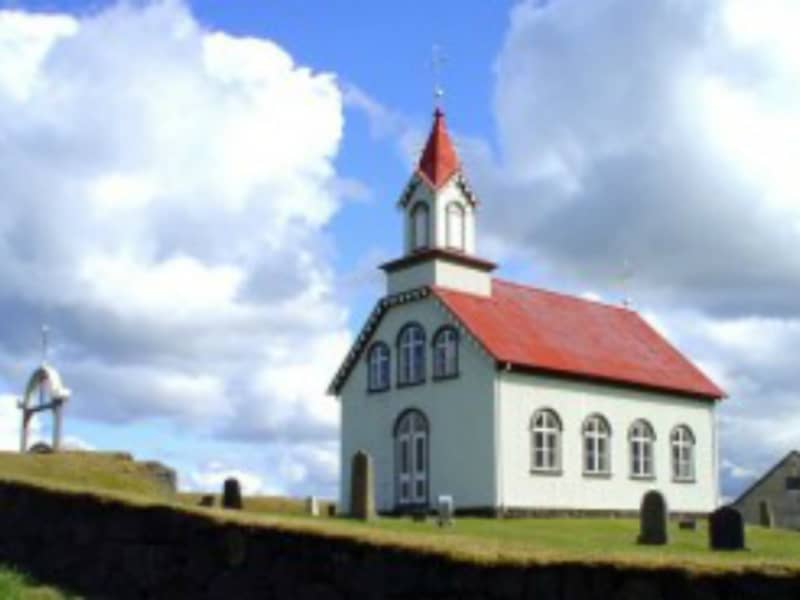
Hraungerdi church
Hraungerði is a church manor and former assembly site. The land once belonged to Hróðgerður the Wise, one of the first settlers and progenitor of the clan Oddverjar. The first mention of a church in Hraungerði is in Bishop Páll’s records from around 1200 AD and since then there have been numerous churches built in Hraungerði. The current church, established in 1902, was designed by architect Eiríkur Gíslason from Bitra and is now preserved.
View
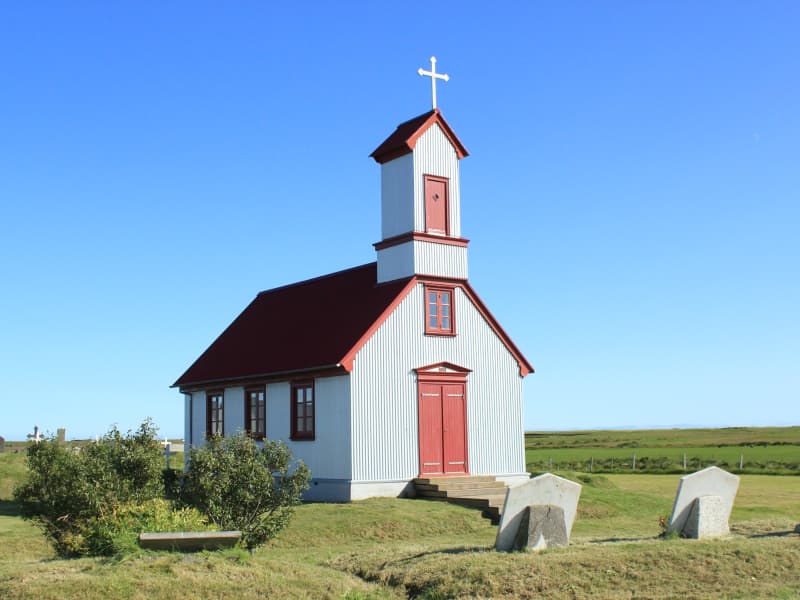
Þykkvabæjarklaustur
Þykkvabæjarklaustur is a present and historic church site snuggled in the Álftaver pseudo crater area. In medieval times this was the location of a catholic monastery, which was founded in 1168 and remained active until the reformation in the mid-16th century. Recent archaeological findings (2015) show that there was an extremely large building of about 1800m2 of ground floor. It was a rich convent of monks with a large farm and a school.
View
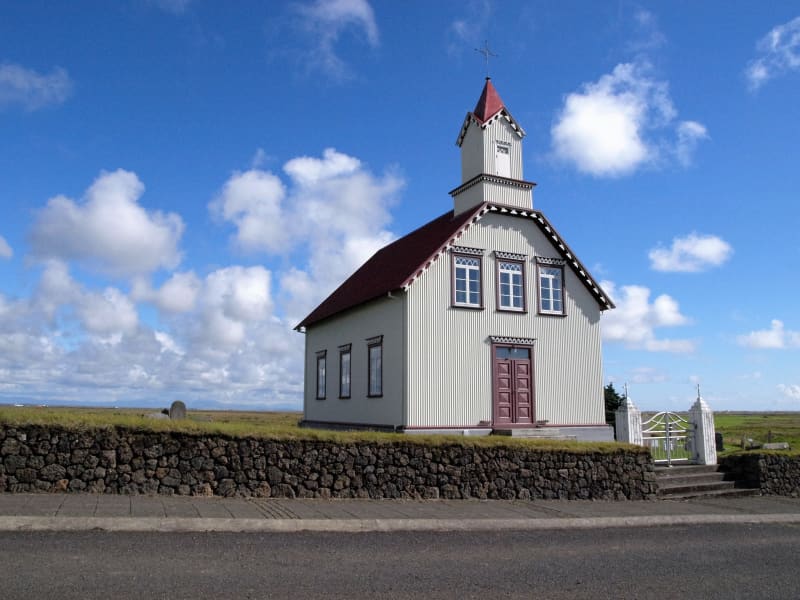
Gaulverjabær church
Gaulverjabær has been a church site and manor since early settlement. Loftur Gamli from Norway was Gaulverjabær's first settler and named the place after people from Gaular in Norway, a province of Sogn and Fjordane. In 1930 a significant collection of 360 silver coins from the first century of Icelandic settlement was discovered at this site. The current church was built in 1909 and has now been preserved.
View
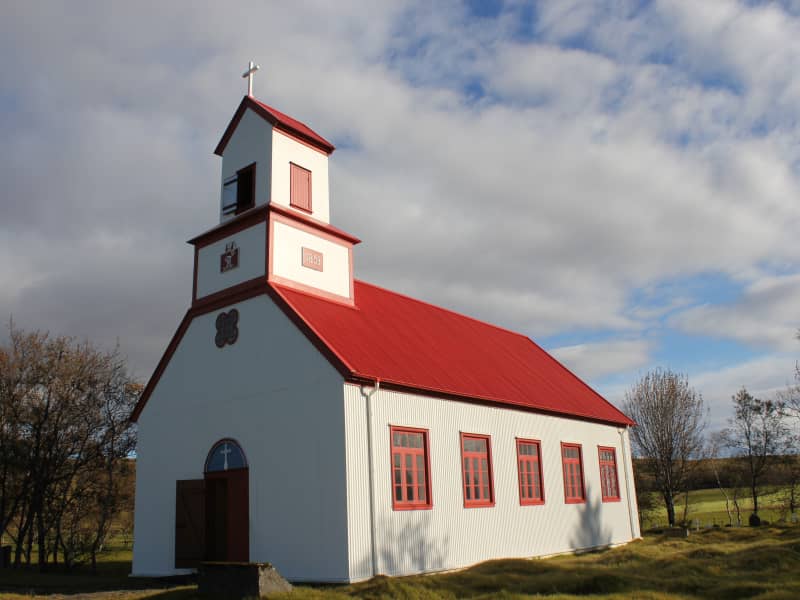
Prestsbakkakirkja á Síðu
Prestsbakki has been an ecclesiastical site since 1859 when church activities at Kirkjubæjarklaustur ceased. The Rev. Jón Steingrímsson (1728-91), known as the "Fire Priest," lived at Prestsbakki. The church at Prestsbakki contains many interesting objects.
View
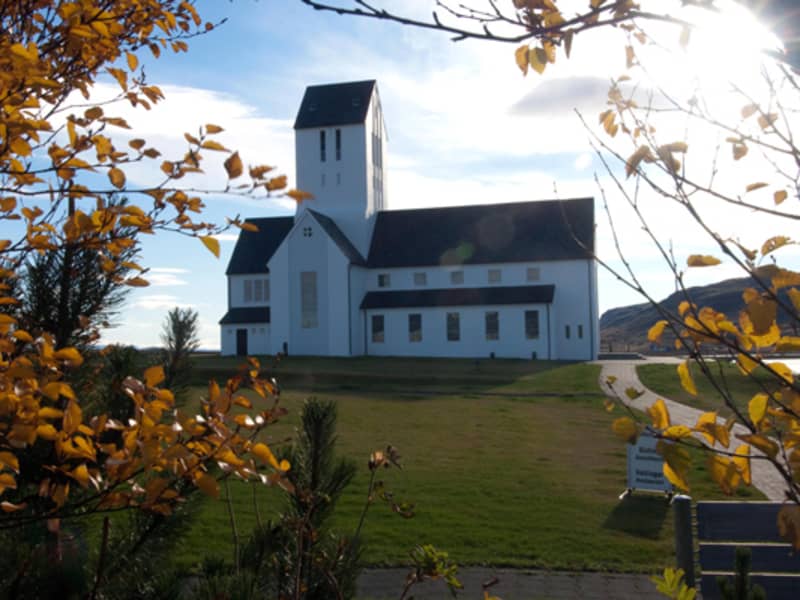
Skálholt Church
Situated in the lower part of the Biskupstungur valley between the rivers Hvítá and Brúará, Skálholt is one of Iceland's places of special historical interest. For seven centuries it was the scene of the most dramatic events which shaped the political, spiritual and cultural life in Iceland. Its early history is traced back to the 11th century when religious disputes were at their sharpest in Iceland. Within two centuries of the settlement of Iceland, the first bishopric was founded at Skálholt in 1056 for South Iceland, and soon a second at Hólar in 1109 for North Iceland.
The man who chose Skálholt as the site of the first Episcopal see in Iceland was Ísleifur (1006 - 1080), son of Gissur the White. Skálholt had earlier been his patrimonial estate and his grandfather, Teitur Ketilbjarnarson, was the first settler there. According to an old account, Skálholt was at that time "the largest town in Iceland". Ísleifur's father, who was a wealthy aristocrat and a redoubtable political figure as well, played a decisive role in the Christianization of Iceland and the future status of the church. He built the first church in Iceland at Skálholt around the year 1000.
In the 12th century bishop Klængur Þorsteinsson built a great cathedral at Skálholt. It was a sumptuous edifice made of timber shipped from Norway. For centuries Skálholt was the centre of learning and culture in Iceland, a status which lasted up to the Reformation in 1550.
In 1954, a team of archaeologists, while digging up the foundations of the old cathedral, came upon a sarcophagus which was believed to contain the skeleton of Páll Jónsson, one of the most powerful bishops of Skálholt. His sarcophagus, together with a few relics found at the scene, is now on display in an underground vault beneath the new memorial church built during 1956-1963 on the site of the old cathedral. All churches in Scandinavia contributed financially to its construction.
The last Catholic bishop of Iceland, Jón Arason, was executed at Skálholt in 1550, along with his two sons. He had opposed the Reformation imposed upon Iceland by King Christian III of Denmark. Today, a memorial stands at the site of the execution. Arason's Episcopal robes are on display at the National Museum of Iceland in Reykjavík.
Today, Skálholt is visited for the new cathedral, the tomb of bishops, the museum, and the collection of ancient books in the tower.
View
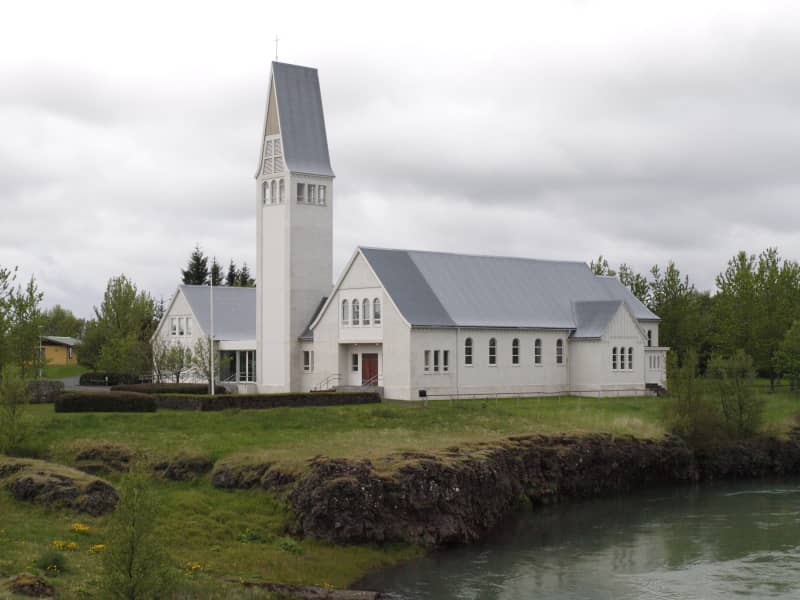
Selfosskirkja - church
Selfoss Church was built from 1952 to 1956 and consecrated on Palm Sunday, 25 March 1956. It was designed by the headmaster of the Technical College in Selfoss, Bjarni Pálsson (1912-1987). The building was expanded between 1978 and 1984; a tower, porch, and congregation hall with a kitchen and facilities, which now serve the purpose of a convention center, was added to the structure.
View
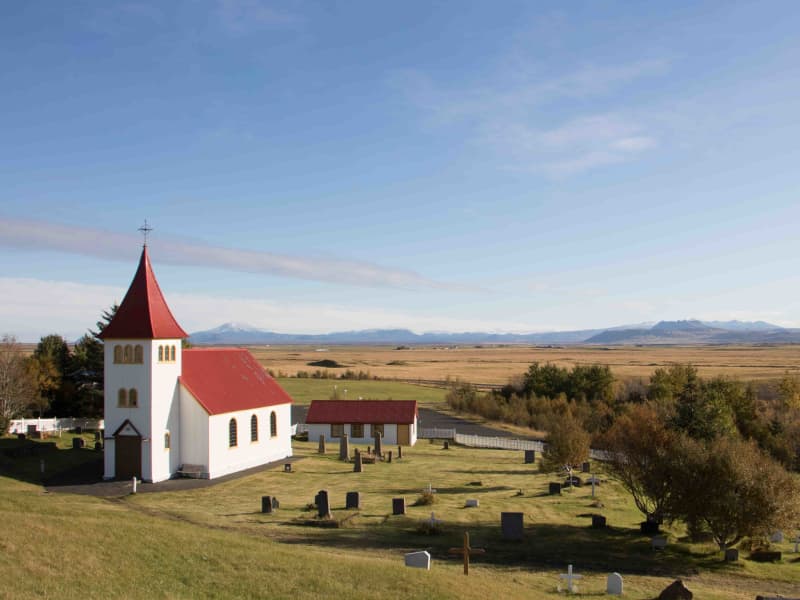
Oddi church
Oddi at Rangárvellir is a historic church site, farm and vicarage. In earlier times, Oddi was one of the most important seats of chieftains and education, with Snorri Sturluson being one notable figure who grew up there.
Oddi stands quite far down in the Rangárvellir region, just between Ytri- and Eystri-Rangá, with the river Þverá flowing just below Oddatorfa. Oddi was a major farm for a number of centuries and was blessed with rich pastures. The farm controlled numerous smallholdings and had enormous influence.
One of the more famous pastors who served at Oddi was poet Matthías Jochumsson, author of Iceland’s National Anthem, whose poetry includes glowing descriptions of the surrounding landscape.
It is believed that a church has stood at Oddi since Icelanders first adopted the Christian faith. The current church is a timber church from 1924 and seats around 100. The church was designed by Guðjón Samúelsson, the State Architect of Iceland. The church was renovated, painted and decorated in 1953 by Gréta and Jón Björnsson and re-consecrated the same year.
Among the most important items owned by the church are a silver chalice believed to be from around 1300, an altarpiece from 1895 showing Christ in the garden of Gethsemane and a baptismal font carved and painted by carpenter Ámundi Jónsson.
During the Commonwealth Era, Oddi was the ancestral home of the Oddverjar clan, one of the most powerful family clans of the period. The most famous member of the family was Sæmundur the Learned Sigfússon. Sæmundur the Learned studied at the Black School (the Sorbonne) in Paris. He was probably one of the first Icelandic historians to write a history of the Kings of Norway, although the manuscript is now lost. The grandson of Sæmundur the Learned was Jón Loftsson, who was one of the most powerful chieftains in Iceland and was, moreover, one of the most respected of them all, the most peaceful and beloved. Jón fostered Snorri Sturluson and educated him.
Six pastors serving in Oddi have become the Bishop of Iceland: Ólafur Rögnvaldsson, Björn Þorleifsson, Ólafur Gíslason, Árni Þórarinsson, Steingrímur Jónsson and Helgi G. Thordarsen.
The Oddi Association (Oddafélagið) was established in 1990. One of the main objectives of the Association is to re-establish the seat of learning at Oddi in Rangárvellir. Members currently number 200, and the patron of the Association is Vigdís Finnbogadóttir, the former President of Iceland. The Association holds the Oddastefna (Oddi conference) each year, where numerous lectures are given on the importance and history of Oddi.
The current pastor of Oddi is Elína Hrund Kristjánsdóttir.
View
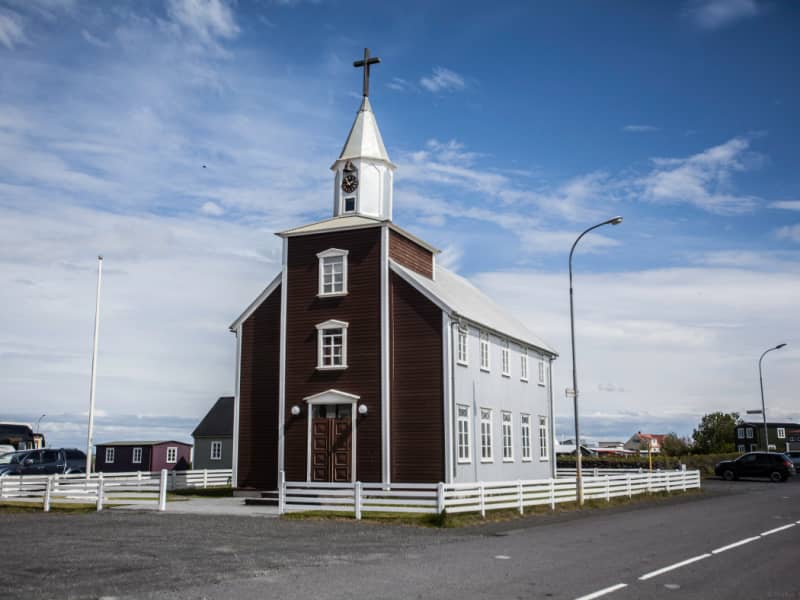
Eyrarbakkakirkja - church
The church in Eyrarbakki was inaugurated in December of 1890. Before that, the people of Eyrarbakki attended services in the neighboring village of Stokkseyri, but as the population of Eyarbakki grew, reaching 702 in 1890, it was time for Eyrarbakki to have its church. The church seats 230-240 people.
The church of Eyrarbakki's main proponent was the Reverend Jón Björnsson, who was a pastor of the church from its opening until 1892. The church was designed by Jóhann Fr. Jónssyni, the chief carpenter in Eyrarbakki from 1880 to 1890, but he died before the church's completion.
One of the main points of interest is the church's altarpiece, which is a painted picture of Jesus talking with the Samaritan woman at Jacob's well (John 4, 13-14). "Whoever drinks of the water that I shall give him, he will never be thirsty." The Reverend Jón Björnsson sailed to Denmark to obtain building materials for the church, and while there, he was given an audience with King Christian IX and Queen Louise. They liked him so well that the queen gave him the church altar she had painted. The altarpiece bears her name and the year 1891.
Other items of interest are the candlesticks from Kaldaðarneskirkja, the church in Kaldaðarnes, which was closed in 1902. The candlesticks, inscribed with the year 1780 and the letters E.S.S. Stjakarnir, are Icelandic craftsmanship and all hand-made. The chandelier also comes from Kaldaðarneskirkja. In 1918, a bell was added to the tower, which rang twice an hour. It was a gift from the Danish merchant James A. Lefolii in memory of the many decades of the Lefolii family in Eyrarbakki.
Extensive renovations to the church were carried out from 1977 to 1979. A new 11-pipe organ by Björgvin Tómasson was put into service on Christmas day, 1995.
View
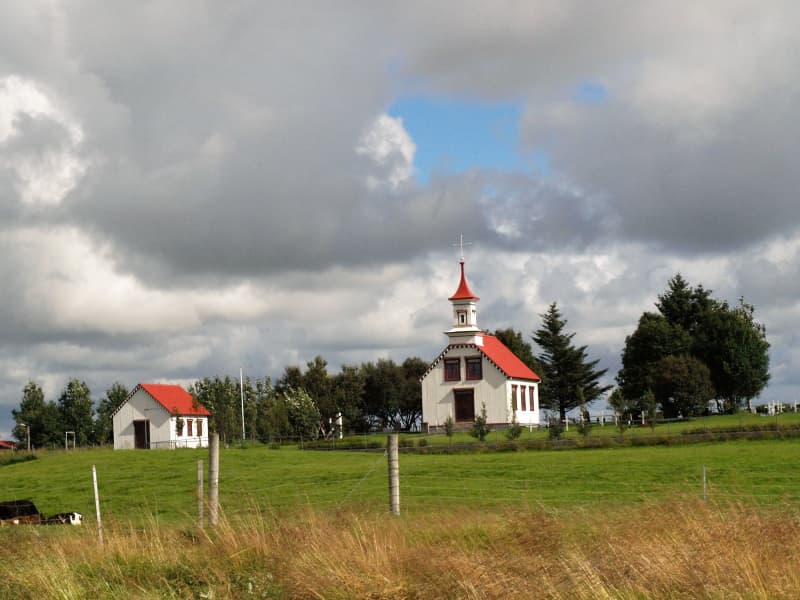
Villingaholt church
A church and farm site and home to the great 17th century saga writer Jón Erlendsson; thanks to his work many of the Icelandic Sagas were preserved that would otherwise have been lost. Later the home of Jón Gestsson (1863-1945) craftsman and farmer who designed and constructed the current church in 1910-1911. The church has a tower, choir loft and seats for 100 people. A little further to the south is a hill next to the school which used to be where the church and farm were located. Due to frequent sandstorms and heavy damage from earthquakes in 1784 they were moved to the current location.
View
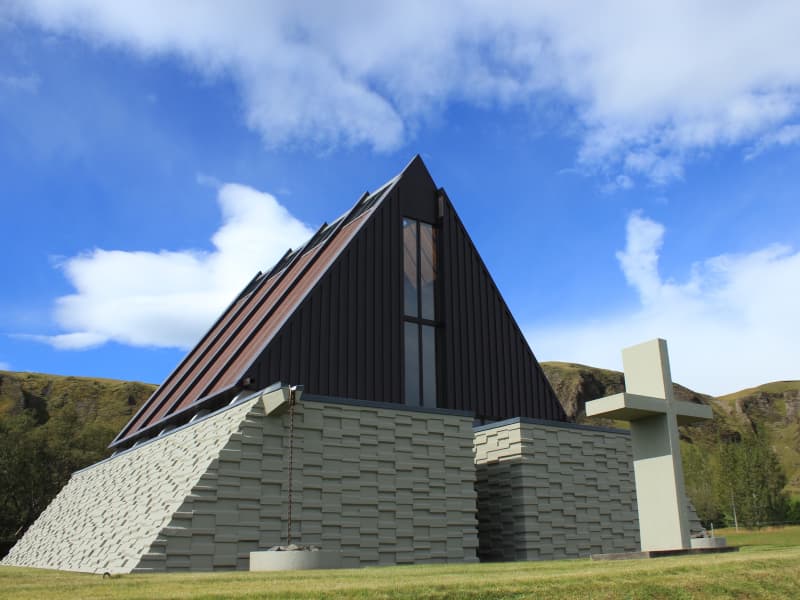
Reverend Jón Steingrímsson chapel
The chapel at Kirkjubæjarklaustur was consecrated in 1974. It was built in the memory of reverend Jón Steingrímsson, fire cleric (1728-1791). He said the famous Eldmessa (Fire Mass) on July 20, 1783, in the church in Klaustur. Many believe that the Eldmessa stopped the stream of the lava that threatened habitation at the time. The place where the stream of lava stopped is now called Eldmessutangi and is to the west of Systrastapi, but the chapel is situated a little to the east of the old church site. According to the Icelandic church, there aren't many stories that are as powerful, clear, and reliable narratives of the value and power of religion and prayer like the ones associated with reverend Jón Steingrímsson and the church in Kirkjubæjarklaustur. The old cemetery in Kirkjubæjarklaustur was fenced in with a concrete wall. There are a few gravestones in the cemetery, among them one at the grave of Reverend Jón Steingrímsson and his wife Þórunn.
View
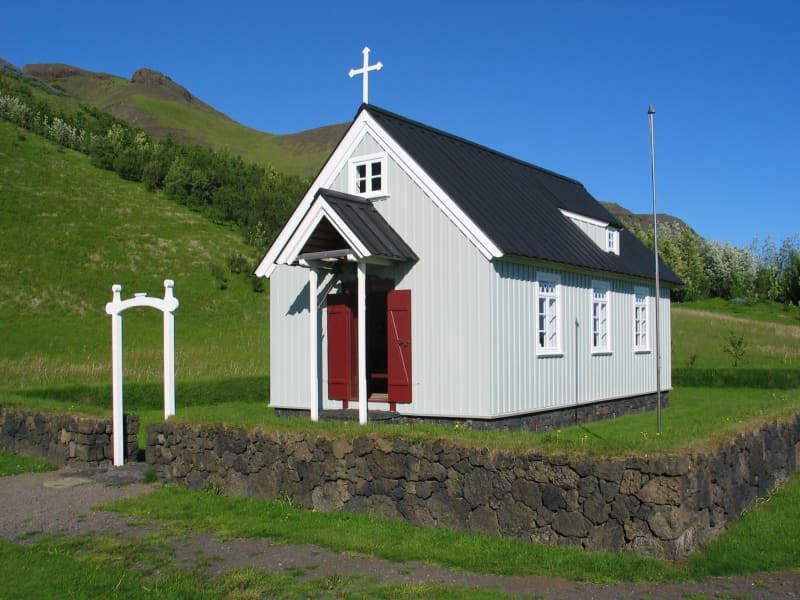
Skogar church
Skógar was a church site from shortly after the adoption of Christianity in Iceland around 1000 AD; the first church was built in about 1100 and dedicated to St. Nicholas. In the early centuries, Skógar Church was wealthy, but after the Reformation of 1550, it declined. The last church at Skógar was a modest wooden church built in the mid-19th century and demolished in 1890.
The present Skógar Church at the museum site was designed by architect Hjörleifur Stefánsson and consecrated in 1998. The exterior structure is new, while most interior fittings are from Kálfholt Church, built in 1879. The windows, which date from 1898, are from Gröf Church. One of the bells, which dates from about 1600, is from Höfðabrekka, the other from Ásar, Skaftártunga, from 1742. All the ecclesiastical goods date from the 17th and 18th centuries. The altarpiece is from Ásólfsskáli Church (1768), the candelabra from Steinar Church and Eyvindarhólar Church (16th century). Various religious ceremonies take place each year in Skógar Church. The church is non-denominational and welcomes all Christian ceremonies.
The present Skógar Church at the museum site was designed by architect Hjörleifur Stefánsson and consecrated in 1998. The exterior structure is new, while most interior fittings are from Kálfholt Church, built in 1879. The windows, which date from 1898, are from Gröf Church. One of the bells, which dates from about 1600, is from Höfðabrekka, the other from Ásar, Skaftártunga, from 1742. All the ecclesiastical goods date from the 17th and 18th centuries. The altarpiece is from Ásólfsskáli Church (1768), the candelabra from Steinar Church and Eyvindarhólar Church (16th century). Various religious ceremonies take place each year in Skógar Church. The church is non-denominational and welcomes all Christian ceremonies.
View
